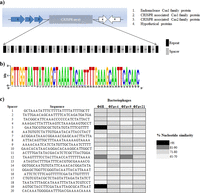Bacteriophage Resistance Mechanisms in Flavobacterium psychrophilum
I personally am uncomfortable with viruses and phages. Their lifestyle and existence seem foreign and abusive to the other organisms that inhabit this planet. As much as I rant on about my dislike for viruses, the curiosity to learn more about them and how they can be combated is how I came to find this article: Bacteriophage Resistance Mechanisms in the Fish Pathogen Flavobacterium psychrophilum: Linking Genomic Mutations to Changes in Bacterial Virulence Factors.
This research is significant in understanding the resistance mechanisms of F. psychrophilum – an important fish pathogen in salmon. Naturally salmon pathogens undergo research to be combated to maintain food production. The rise of antibiotic resistance in F. psychrophilum has caused some to look toward bacteriophages as an alternative.
In order to identify various resistance mechanisms of the fish pathogen, many phage-resistant strains were tested in order to identify infection, physiological structures, DNA sequences, etc. Bacteria was grown and cultured in order to be infected by the bacteriophages. Several assays were done such as the gliding assay (bacterial motility), biofilm formation assay, and an extracellular enzyme activity assay.

(a) graphic representation of CRISPER1 in the F. psychrophilum strain 950106-1/1
(b) nucleotide comparison repeats of CRISPR1 in F. psychrophilum strain 950106-1/1
(c) All six phage-resistant isolates derived from the ancestral strain show the same nucleotide sequences int he spacer and repeat contents.
The figure above shows the similarities in nucleotide sequences between the ancestral strain and phage-resistant bacteriophages. The overall research suggests that spontaneous mutations affect resistance in F. psychrophilum. This research strongly suggests that less bacterial virulence in F. psychrophilum is associated with bacteriophage resistance – this is an area still needed to be researched and confirmed.
Citation: Castillo D, Christiansen RH, Dalsgaard I, Madsen L, Middelboe M. 2015. Bacteriophage resistance mechanisms in the fish pathogen Flavobacterium psychrophilum: linking genomic mutations to changes in bacterial virulence factors. Appl Environ Microbiol 81:1157–1167. doi:10.1128/AEM.03699-14.
Authors: Daniel castillo, Roi Hammershaimb Christiansen, Inger Dalsgaard, Lone Madsen, Mathias Middelboe
Search Path:
- Database: Web of Science
- Topic: Bacteriophage
- Document Type: Article
- Published Year(s): 2015
- Language: English
- Web of Science Category: Biotechnology and Applied Microbiology
- Research Area: Biotechnology Applied Microbiology or Microbiology
- Timespan: All years
- Number of Hits: 126